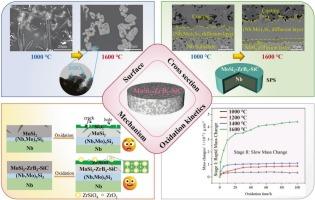将废MoSi2升级为高性能复合涂层,用于在宽温度范围内保护耐火合金
IF 4.6
2区 材料科学
Q2 MATERIALS SCIENCE, MULTIDISCIPLINARY
International Journal of Refractory Metals & Hard Materials
Pub Date : 2025-06-20
DOI:10.1016/j.ijrmhm.2025.107295
引用次数: 0
摘要
•为了回收工业固体废物并探索其在极端环境中的应用,将废弃的MoSi2加热元件重新利用,在铌上制备了MoSi2- zrb2 - sic复合表面涂层。系统地研究了涂层在1000 ~ 1600 °C范围内的高温氧化行为。放电等离子烧结制备出无裂纹、相分布均匀的涂层,并在界面处形成(Nb,Mo)5Si3扩散层,增强了结合。在1000-1200 °C时,SiO2生长不完全,而1400-1600 °C时,涂层表面形成了连续的Zr-Si-O氧化膜,提高了热稳定性和抗氧化性。这种可持续的方法回收了工业废料,并在高温下保护了耐火合金。本文章由计算机程序翻译,如有差异,请以英文原文为准。

Upcycling waste MoSi2 into high-performance composite coatings for protecting refractory alloys across a wide temperature range
- •To recycle industrial solid waste and explore its applications in extreme environments, waste MoSi2 heating elements were repurposed to create a MoSi2-ZrB2-SiC composite surface coating on niobium. The coating's high-temperature oxidation behavior was systematically studied from 1000 to 1600 °C. Spark plasma sintering produced a crack-free coating with uniform phase distribution, and a (Nb,Mo)5Si3 diffusion layer formed at the interface, enhancing bonding. At 1000–1200 °C, incomplete SiO2 growth was observed, while 1400–1600 °C facilitated a continuous Zr-Si-O oxide scale on the coating surface, improving thermal stability and oxidation resistance. This sustainable method recycles industrial waste and protects refractory alloys at high temperatures.
求助全文
通过发布文献求助,成功后即可免费获取论文全文。
去求助
来源期刊
CiteScore
7.00
自引率
13.90%
发文量
236
审稿时长
35 days
期刊介绍:
The International Journal of Refractory Metals and Hard Materials (IJRMHM) publishes original research articles concerned with all aspects of refractory metals and hard materials. Refractory metals are defined as metals with melting points higher than 1800 °C. These are tungsten, molybdenum, chromium, tantalum, niobium, hafnium, and rhenium, as well as many compounds and alloys based thereupon. Hard materials that are included in the scope of this journal are defined as materials with hardness values higher than 1000 kg/mm2, primarily intended for applications as manufacturing tools or wear resistant components in mechanical systems. Thus they encompass carbides, nitrides and borides of metals, and related compounds. A special focus of this journal is put on the family of hardmetals, which is also known as cemented tungsten carbide, and cermets which are based on titanium carbide and carbonitrides with or without a metal binder. Ceramics and superhard materials including diamond and cubic boron nitride may also be accepted provided the subject material is presented as hard materials as defined above.

 求助内容:
求助内容: 应助结果提醒方式:
应助结果提醒方式:


